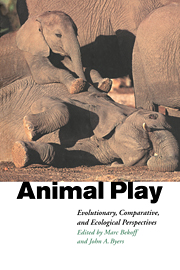Book contents
- Frontmatter
- Contents
- List of contributors
- Introduction
- 1 The evolutionary origins of play revisited: lessons from turtles
- 2 Play in common ravens (Corvus corax)
- 3 Object play by adult animals
- 4 Kangaroos at play: play behaviour in the Macropodoidea
- 5 Intentional communication and social play: how and why animals negotiate and agree to play
- 6 Structure-function interface in the analysis of play fighting
- 7 Sparring as play in young pronghorn males
- 8 Squirrel monkey play fighting: making the case for a cognitive training function for play
- 9 Self assessment in juvenile play
- 10 Biological effects of locomotor play: getting into shape, or something more specific?
- 11 Neurobiological sustrates of play behavior: glimpses into the structure and function of mammalian playfulness
- 12 Play as an organizing principle: clinical evidence and personal observations
- Index
4 - Kangaroos at play: play behaviour in the Macropodoidea
Published online by Cambridge University Press: 20 November 2009
- Frontmatter
- Contents
- List of contributors
- Introduction
- 1 The evolutionary origins of play revisited: lessons from turtles
- 2 Play in common ravens (Corvus corax)
- 3 Object play by adult animals
- 4 Kangaroos at play: play behaviour in the Macropodoidea
- 5 Intentional communication and social play: how and why animals negotiate and agree to play
- 6 Structure-function interface in the analysis of play fighting
- 7 Sparring as play in young pronghorn males
- 8 Squirrel monkey play fighting: making the case for a cognitive training function for play
- 9 Self assessment in juvenile play
- 10 Biological effects of locomotor play: getting into shape, or something more specific?
- 11 Neurobiological sustrates of play behavior: glimpses into the structure and function of mammalian playfulness
- 12 Play as an organizing principle: clinical evidence and personal observations
- Index
Summary
Introduction
The Macropodoidea (kangaroos, wallabies and rat-kangaroos) are the most distinctive and widely recognised of Australia's unique native fauna. All macropodoids are fundamentally similar in body form (Flannery 1984) but they nevertheless display an amazing diversity of species, habitat preferences and lifestyles. There are over 60 extant species [new species are still being discovered (Flannery et al. 1995) and active speciation in rock-wallabies (Petrogale) has led to considerable flux in their taxonomy (Eldridge & Close 1992)] divided into two families: the Potoroidae (rat-kangaroos, bettongs and potoroos) and the more derived Macropodidae (‘true’ wallabies and kangaroos). There are small (< 1 kg), solitary, homomorphic rainforest species (e.g. Musky Rat-kangaroo, Hypsiprymnodon moschatus) and large (>90 kg), gregarious, hetero-morphic species of the open arid and semi-arid plains (Red Kangaroo, Macropus rufus). There are arboreal tree-kangaroos (Dendrolagus) in the rainforests of northern Australia and New Guinea, a bettong that burrows like a rabbit (Burrowing Bettong, Bettongia lesueur) and species adapted to rocky outcrops and escarpments (rock-wallabies, Petrogale and Peradorcas, and Common Wallaroo, Macropus robustus). The range of adaptations in macropodoids was considered by Flannery (1989) to be greater than that of any placental family or superfamily with the exception of murids.
The closest placental equivalent to macropodoids are the Artiodactyla, particularly the Cervidae and Bovidae. Despite some 130 million years of phyletic separation, macropodoids and artiodactyls display striking behavioural and ecological convergence as comparisons of Jarman (1974) and Kaufmann (1974a, b) demonstrate. Macropodoids and artiodactyls represent alternative evolutionary pathways for large-bodied herbivorous mammals and this offers excellent opportunities for phylo-genetic comparisons of play.
- Type
- Chapter
- Information
- Animal PlayEvolutionary, Comparative and Ecological Perspectives, pp. 61 - 96Publisher: Cambridge University PressPrint publication year: 1998
- 12
- Cited by

